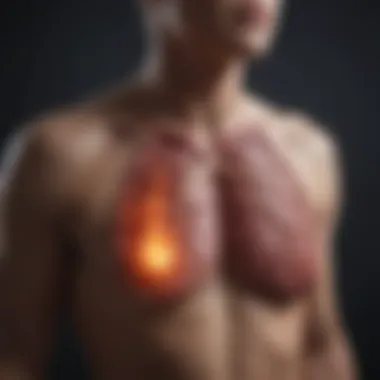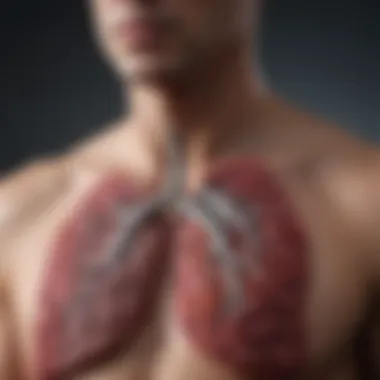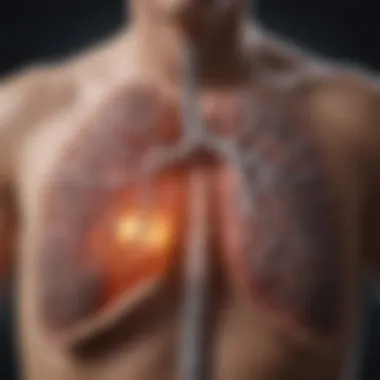Lung Recovery After Quitting Smoking: A Detailed Analysis


Intro
Quitting smoking is a significant step towards improving one’s health, particularly the respiratory system. When an individual stops smoking, the lungs initiate a complex recovery process. Understanding the physiological changes that occur is crucial for anyone seeking to grasp the implications of smoking cessation.
The recovery process is characterized by various stages, each with its distinct timeline and changes. Throughout the following sections, we will explore the key concepts related to lung recovery, current research trends, and factors influencing the healing process. This knowledge is essential not only for ex-smokers but also for healthcare professionals and researchers interested in respiratory health.
Preface to Lung Recovery
Understanding how lungs recover after quitting smoking is essential for anyone looking to improve their respiratory health. The physiological changes that take place post-cessation are significant. They not only impact the lungs but also overall well-being. Recognizing these changes can motivate individuals to maintain their decision to quit.
This section provides vital insights into lung recovery. It covers how the lungs function, the effects of smoking, and the potential for regeneration. Benefits of quitting smoking often include improved lung function, reduced risks of respiratory diseases, and enhanced quality of life. However, each individual's journey is different.
As the body begins to heal, certain considerations become crucial for understanding lung progress. It is important to note that recovery is gradual. Awareness of what to expect during this time can relieve anxiety and promote adherence to smoking cessation programs. Exploring the anatomy of the lungs sets a foundational understanding of these recovery processes.
Understanding Lung Anatomy
The lungs are vital for gas exchange. They take in oxygen and expel carbon dioxide. Comprised of various parts, including bronchi, bronchioles, and alveoli, each component plays a role in respiratory function. The bronchi are the main air passages that branch into smaller tubes. These lead to bronchioles, which end in clusters of tiny air sacs called alveoli. Alveoli are where the actual exchange of gases occurs.
Healthy lung structure is essential for efficient oxygen intake. However, when smoke from cigarettes infiltrates the lungs, it causes damage. Tar and other toxins accumulate over time, leading to inflammation and reduced lung capacity. The interconnectedness between lung structure and function underscores the importance of recovery.
The Impact of Smoking on Lung Function
Smoking detrimentally alters lung physiology. It leads to decreased lung elasticity and narrowed airways. Over time, this results in symptoms such as chronic wheezing, coughing, and shortness of breath.
The inhalation of toxic substances negatively affects the cilia in the lungs. Cilia are small hair-like structures that help clear mucus and debris. When these are damaged, it becomes harder for the lungs to self-cleanse.
In addition to these mechanical impacts, smoking can cause inflammation in the lung tissues. This inflammation is often a precursor to chronic obstructive pulmonary disease (COPD) and other serious conditions. Understanding these impacts is crucial when looking at lung recovery post-smoking.
"Awareness of lung function impairment is the first step towards recovery. Understanding what smoke does helps in appreciating the healing period."
"Awareness of lung function impairment is the first step towards recovery. Understanding what smoke does helps in appreciating the healing period."
Physiological Changes After Quitting Smoking
The process of quitting smoking initiates a series of physiological changes in the lungs, which are crucial for understanding lung recovery. Understanding these changes can help former smokers appreciate the benefits of cessation and motivate them to continue on the path to lung health. Importantly, each stage of recovery contributes to restoring lung function and reducing the risk of further health complications.
Immediate Changes in Lung Health
The first few days after quitting smoking involve significant physiological changes. The respiratory system begins to clear out mucus, debris, and toxins accumulated during smoking. As a result, many individuals will experience improved lung capacity and better airflow. Within just 20 minutes, heart rate and blood pressure begin to drop, promoting better circulation. This is a clear sign that the body is reacting positively to the absence of nicotine and harmful smoke.
Most notable changes include:
- Ciliary function recovery: Cilia, tiny hair-like structures in the lungs, start regaining their ability to move efficiently, aiding in the clearance of mucus.
- Enhanced oxygen levels: Oxygen levels in the blood increase as carbon monoxide, a harmful gas found in cigarette smoke, decreases.
- Reduction in bronchial inflammation: Inflammation caused by smoking gradually subsides, leading to improved breathing comfort.
Thus, even in the immediate aftermath of cessation, the body starts reclaiming its health, providing a foundation for longer-term recovery.
Long-term Recovery Evolution


Over time, the changes in lung health become even more pronounced. Long-term recovery can vary widely among individuals, often depending on the duration and intensity of smoking history, genetics, and environmental factors. Typically, the following stages mark the evolution of lung recovery:
- Months Post-Cessation: During the first year, lung function can improve significantly, with many seeing a reduction in chronic cough and wheezing. The risk of respiratory infections decreases, allowing the lungs to operate more effectively.
- 2 to 5 Years: Continued improvement can be noted as the risk of lung cancer and other chronic diseases diminishes. This period is crucial for the lungs to repair any structural damage.
- After 10 Years: Studies indicate that after a decade of not smoking, the risk of lung cancer approaches that of a non-smoker. This demonstrates the resilience of lung tissue and the importance of long-term cessation.
"The lungs have a remarkable ability to heal, but the time it takes varies based on several individual factors."
"The lungs have a remarkable ability to heal, but the time it takes varies based on several individual factors."
Timeline of Lung Healing Post-Cessation
Understanding the timeline of lung recovery after smoking cessation is essential for individuals who have decided to quit. It provides clarity on what they might experience and can serve as motivation throughout the recovery process. Knowing the stages of healing helps in setting realistic expectations and in recognizing the gradual nature of lung recovery. This section explains the critical phases in the timeline and highlights the physiological processes that occur at each stage, emphasizing their significance in improving overall respiratory health.
First Days: Initial Recovery Stages
In the first days after quitting smoking, the body begins an impressive healing process. Within just 20 minutes, heart rate and blood pressure may drop. However, the most noticeable changes occur in the lungs.
- Cilia Functionality: The cilia, tiny hair-like structures in the airways, start to regain functionality. Cilia are responsible for clearing mucus and debris from the lungs, which often becomes compromised due to smoking. The return of cilia activity marks the beginning of lung cleansing.
- Reduction in Nicotine Levels: As nicotine levels drop, withdrawal symptoms may occur, but this signal indicates that the body is starting to recover from addiction.
- Improved Airway Function: Although the immediate physical improvements may be subtle, the respiratory system begins to work more effectively. The reduction of carbon monoxide in the bloodstream leads to better oxygen distribution throughout the body.
"The early days post-cessation are crucial for laying the groundwork for future recovery."
"The early days post-cessation are crucial for laying the groundwork for future recovery."
This immediate stage can be enabling for those who have quit, reinforcing the decision to overcome addiction.
Weeks to Months: Continued Progression
As time progresses to weeks and months after quitting, individuals may notice significant changes in their lung health. This period is characterized by various physiological adaptations.
- 2 Weeks to 3 Months: During this period, lung function significantly improves. Lung capacity can increase by as much as 30%. Many experience a decrease in coughing and shortness of breath.
- Mucus Clearance: With the cilia functioning effectively, mucus secretion decreases. The body expels the tar and other toxins accumulated during the smoking years. Some people may initially experience a temporary increase in coughing as the lungs expel these substances.
- Enhanced Respiratory Health: The risk of respiratory infections reduces. A study showed that ex-smokers experienced fewer respiratory issues compared to current smokers. This period of recovery can also lead to improved energy levels and better overall well-being.
Years: Potential for Full Recovery
Long-term recovery, occurring over months to years post-cessation, brings the potential for complete lung healing.
- 5 Years and Beyond: Studies suggest that within five years, the risk of stroke may align with that of a non-smoker. After 10 years, the risk of lung cancer may drop significantly, although it may still be higher than that of a person who has never smoked.
- Continued Improvement in Lung Function: Lung function continues to improve over the years. Some studies report that chronic obstructive pulmonary disease (COPD) progression might slow down or even stabilize for some individuals if they remain smoke-free.
- Possible Full Recovery: For many, the lungs can recover very well, and the sensation of breathing becomes significantly easier. Individuals often report a greater capacity for physical activity and improved quality of life.
Factors Influencing Lung Recovery
Understanding the factors that influence lung recovery after quitting smoking is essential for comprehending the overall healing process. Various elements play a crucial role in determining the rate and extent of lung regeneration. Recognizing these can help individuals set realistic expectations for their rehabilitation journey and guide healthcare providers in tailoring interventions effectively.
Age and Gender
Age is a significant determinant influencing lung recovery. Younger individuals often exhibit more robust healing capabilities compared to older adults. This is primarily due to the natural decline in lung function and overall physiological resilience that accompanies aging. Moreover, men and women may experience different outcomes due to biological and lifestyle factors. For instance, research suggests that women may recover lung function more rapidly than men after quitting smoking, though this can vary widely depending on individual health conditions.
Duration and Intensity of Smoking
The duration and intensity of the smoking habit considerably affect the extent of lung damage and the subsequent recovery process. Long-term smokers typically face greater challenges in healing. The cumulative impact of years spent smoking leads to structural changes in lung tissue and capacity. Conversely, shorter smoking histories often correlate with a more favorable prognosis for lung regeneration post-cessation. Understanding this relationship enables health professionals to provide better advice about quitting smoking and its potential benefits, emphasizing the importance of cessation regardless of the smoking history.
Environmental and Genetic Factors


Environmental influences, such as exposure to pollutants and occupational hazards, can hinder lung recovery. People living in areas with high air pollution levels may experience slower healing rates, as their lungs are subjected to ongoing stress from harmful substances. Furthermore, genetic predispositions can also dictate individual recovery pathways. Genetic variations can affect how one’s body responds to damage and facilitates healing. Knowledge of these factors can help in creating personalized recovery plans that take into account an individual’s unique challenges and needs.
"Each person's lung health trajectory after quitting smoking is shaped by a combination of age, smoking history, environmental conditions, and genetics. Adapting recovery strategies to these factors can significantly enhance outcomes."
"Each person's lung health trajectory after quitting smoking is shaped by a combination of age, smoking history, environmental conditions, and genetics. Adapting recovery strategies to these factors can significantly enhance outcomes."
These factors create a complex landscape that dictates recovery trajectories, emphasizing the need for ongoing research and individualized approaches to support lung health.
Potential Complications During Recovery
The process of recovering lung function is not without its challenges. Understanding potential complications is crucial for anyone who has recently quit smoking. Awareness of these issues can help in monitoring health and seeking timely medical assistance if needed. The recovery journey involves many physiological changes that can sometimes predispose ex-smokers to certain health threats. This section addresses specific complications that may arise, including the risk of respiratory infections, the development of chronic conditions, and the impact of lung inflammation.
Risk of Respiratory Infections
After quitting smoking, the lungs begin to clear out mucus and toxins. This can temporarily reduce lung capacity and hamper the immune response. As a result, ex-smokers may find themselves more vulnerable to respiratory infections in the short term. The cilia in the lungs start to function better, but improvements take time. It is crucial to understand that during this interim period, individuals are at risk of infections such as pneumonia and bronchitis.
Regular hand washing and avoiding close contact with sick individuals can help mitigate this risk. Monitoring symptoms early is essential, as prompt treatment can lead to better outcomes.
Development of Chronic Conditions
In some cases, quitting smoking does not entirely eliminate the risk of chronic respiratory diseases. Individuals with a history of prolonged smoking might already have underlying issues, such as chronic obstructive pulmonary disease (COPD) and emphysema. As the lungs begin to heal, signs of these chronic conditions may remain or even worsen. Furthermore, inflammation from earlier smoking periods can lead to irreversible damage, complicating lung recovery efforts.
Regular health check-ups and consultations with healthcare professionals can allow for early detection of any developing chronic conditions, ensuring that appropriate interventions are put in place to manage them effectively.
Role of Lung Inflammation
Lung inflammation is a common response following smoking cessation. This inflammation is a natural part of the healing process, but it can also lead to complications. For example, prolonged inflammation can contribute to chronic conditions, as mentioned previously. This is due to the ongoing presence of irritants that can sustain a cycle of damage and repair.
The development of effective strategies to manage inflammation is important. This may include medication that reduces inflammation, lifestyle changes like improved diet and exercise, and consistent monitoring of lung health. Understanding the mechanisms at play can lead to more informed decisions regarding treatment options.
It is vital for ex-smokers to remain vigilant about their lung health to reduce the risk of complications. The journey to recovery demands not only patience but also proactive health management.
It is vital for ex-smokers to remain vigilant about their lung health to reduce the risk of complications. The journey to recovery demands not only patience but also proactive health management.
Role of Medical Intervention
Medical intervention plays a critical role in the recovery process for individuals who have recently quit smoking. It facilitates an environment where the lungs can heal more effectively and allows patients to regain their respiratory function more efficiently. The importance of this topic lies in understanding how structured programs and medical treatments contribute to overall lung health post-smoking cessation.
When individuals stop smoking, they often face a range of symptoms and challenges. These can include withdrawal symptoms, cravings, and respiratory issues. Medical interventions can help in managing these challenges and provide essential support during the healing journey. Addressing both physical and psychological aspects of the recovery process, these interventions can enhance the probability of long-term success in quitting smoking.
Pulmonary Rehabilitation Programs
Pulmonary rehabilitation programs are designed to support lung function improvement in patients who have quit smoking. These programs typically include a combination of physical exercise, education, and nutritional counseling.
**Key Elements of Pulmonary Rehabilitation:
- Individualized Exercise Plans:** Tailored activities that consider the patient’s current lung function and fitness level.
- Education: Instructs patients about lung health, smoking cessation, and coping strategies for cravings or negative emotions.
- Nutritional Counseling: Offers advice on diet modifications that can support lung recovery and general health.


These programs have shown to increase exercise tolerance, improve quality of life, and reduce feelings of anxiety. They also provide a structured environment that can help motivate individuals to adhere to their recovery plans. Patients often report increased confidence in managing their health and well-being after participation in these programs.
Medication and Treatment Options
Various medications and treatment options can assist individuals in recovering from the effects of smoking. These can be particularly important for those experiencing chronic symptoms or complications related to smoking cessation.
Common Medication Options:
- Nicotine Replacement Therapies: This includes patches, gums, or lozenges that provide controlled doses of nicotine to reduce withdrawal symptoms.
- Bupropion: An antidepressant that can help with mood stabilization while also reducing cravings for cigarettes.
- Varenicline: A medication that targets nicotine receptors in the brain, helping to reduce cravings and withdrawal symptoms.
Considerations for Medication Use:
- Consultation with a Healthcare Professional: It is essential to have discussions with healthcare providers to assess which options may be most suitable, considering existing medical conditions and personal health history.
- Monitoring Side Effects: Awareness of potential side effects and interactions with other medications is critical.
- Adherence to Prescriptions: Patients must follow prescribed guidelines for medication to achieve optimal results.
In summary, medical interventions, including pulmonary rehabilitation programs and appropriate medications, are instrumental in the recovery journey after quitting smoking. They provide necessary support to individuals, helping to mitigate complications and enhance lung health. As such, it is crucial to embrace these available resources for effective long-term recovery.
Monitoring Lung Health After Quitting
Monitoring lung health after quitting smoking is crucial for individuals aiming to restore their respiratory function. This process is not merely about seeing if symptoms improve; it encompasses a broader understanding of how lungs recover from the impact of smoking. Regular assessments can aid in detecting complications early and provide insight into the effectiveness of recovery strategies.
Importance of Regular Check-ups
Regular check-ups play an important role in post-smoking health management. After quitting, individuals might experience changing symptoms or new respiratory issues. These health evaluations help in:
- Tracking Recovery: Regular visits allow healthcare providers to monitor lung function and assess the healing process.
- Early Detection of Issues: Some conditions may develop unnoticed. Regular evaluations can catch these problems early, leading to better outcomes.
- Providing Support: Health care professionals can offer advice on lifestyle changes, nutrition, and exercise which are essential in improving lung health.
Studies show that individuals who engage in consistent medical follow-ups tend to report lower instances of chronic lung conditions in the long term.
Use of Diagnostic Tools
Diagnostic tools are invaluable for understanding lung health after smoking cessation. They provide clear insights into lung function and highlight areas needing attention. Commonly used diagnostic tools include:
- Spirometry: This test measures how much air a person can breathe in and out, and how quickly they can do it. It is critical in assessing the presence of chronic obstructive pulmonary disease (COPD).
- Chest X-rays: These images help detect any abnormalities in lung structure, identifying potential areas of concern.
- CT scans: A more detailed imaging tool that provides a comprehensive view of the lungs, CT scans can identify small nodules or tumors.
- Bronchoscopy: This procedure enables direct visualization of the airways, allowing for biopsy if necessary.
Utilizing these tools provides a baseline to compare future health and ensures that any deviations from expected progress are addressed promptly.
"Early detection and intervention can significantly improve lung health outcomes in individuals post-smoking."
"Early detection and intervention can significantly improve lung health outcomes in individuals post-smoking."
Culmination
Understanding the progression of lung recovery after quitting smoking is crucial for former smokers and healthcare professionals alike. The insights provided in this article highlight the importance of a multi-faceted approach to lung health in the post-cessation phase, emphasizing the dynamic changes that occur in respiratory physiology.
Key Takeaways on Lung Progression
- Lungs Show Significant Recovery: The lungs are remarkably resilient and can show significant healing, even years after the last cigarette. This recovery is influenced by several factors, including age, gender, and the length of time spent smoking.
- Importance of Monitoring: Regular check-ups are vital. They aid in catching potential complications early and allow for better management of lung health.
- Role of Medical Support: Medical interventions, such as pulmonary rehabilitation programs, play a significant role in facilitating a smoother recovery process. They can provide tailored exercises and education, drastically reducing the risk of chronic conditions.
- Recognizing Symptoms Early: Being aware of symptoms like persistent cough or shortness of breath is essential. Such conditions may arise during recovery but could signal underlying issues if they persist.
Future Research Directions
Future studies should focus on several aspects:
- Long-term Effects of Cessation: More extensive longitudinal studies are necessary to understand the long-term recovery potential of the lungs after various durations of smoking.
- Genetic Factors: Exploring how genetic predispositions impact recovery can lead to personalized approaches for different patients.
- Environmental Influences: Further research into how environmental factors, such as pollution and second-hand smoke exposure, affect lung recovery will enhance the understanding of recovery dynamics.
In summation, the journey towards lung recovery is complex yet encouraging. Continued investigation and support can provide individuals with a roadmap to better respiratory health post-smoking.







